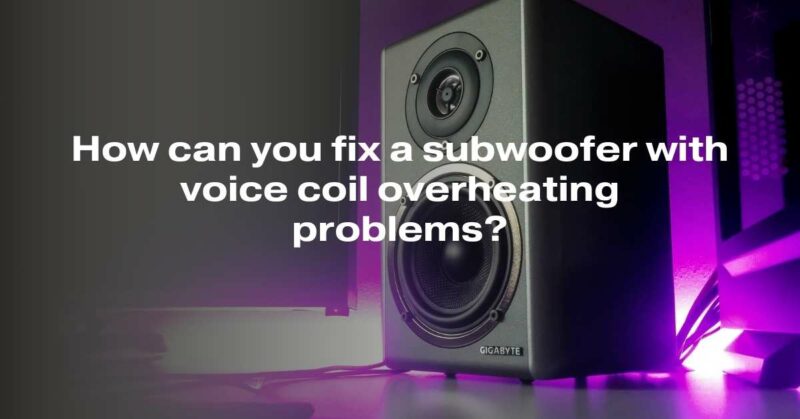Subwoofers are essential components of a high-quality audio system, providing deep bass and immersive sound experiences. However, like any mechanical device, they can encounter issues over time. One common problem is voice coil overheating, which can lead to reduced performance or even permanent damage. In this comprehensive guide, we’ll explore the causes of voice coil overheating in subwoofers and provide step-by-step instructions on how to fix this issue effectively.
Understanding Voice Coil Overheating
A subwoofer’s voice coil is a crucial component responsible for producing sound. It consists of a coil of wire wound around a cylindrical form that moves within the magnetic field of the subwoofer’s magnet. When an audio signal passes through the coil, it generates vibrations that produce sound waves.
Voice coil overheating occurs when the coil becomes too hot during prolonged use or due to various factors. When the coil overheats, it can lead to distortion, loss of sound quality, and in severe cases, permanent damage to the subwoofer. Understanding the causes is essential for effective troubleshooting.
Common Causes of Voice Coil Overheating
- Overpowering the Subwoofer: Using an amplifier that delivers more power than the subwoofer can handle is a common cause of overheating. This excess power can cause the voice coil to heat up excessively.
- Improper Enclosure: The type of enclosure used for the subwoofer can affect its cooling. A sealed enclosure can trap heat, leading to overheating, while a vented or ported enclosure may provide better cooling.
- Incorrect Wiring: Incorrect wiring configurations can result in impedance mismatches and cause the amplifier to deliver more power than the subwoofer can handle.
- Inadequate Ventilation: Poor airflow around the subwoofer can lead to heat buildup. Subwoofers need adequate ventilation to dissipate heat effectively.
- Prolonged High-Volume Use: Continuous operation at high volumes can cause the voice coil to heat up rapidly, especially if it’s being overdriven.
Fixing Voice Coil Overheating Problems
Now that we understand the causes, let’s explore how to fix voice coil overheating problems:
- Check Power Handling: Ensure that your amplifier’s power output matches the subwoofer’s power handling specifications. If the amplifier is too powerful, consider upgrading the subwoofer or reducing the amplifier’s output.
- Inspect Wiring: Double-check the wiring connections. Ensure that the impedance of the subwoofer matches the amplifier’s output and that all connections are secure and correctly configured.
- Optimize Enclosure: If you’re using a sealed enclosure, consider switching to a vented or ported design for better cooling. Ensure that the enclosure is the correct size for your subwoofer.
- Improve Ventilation: Ensure there’s adequate airflow around the subwoofer. Avoid placing it in enclosed spaces or near heat sources. Using fans or cooling systems can also help dissipate heat.
- Monitor Volume Levels: Be mindful of your subwoofer’s volume levels. Avoid prolonged high-volume use, as this can cause overheating. Consider adding a subwoofer limiter or using a bass management system to prevent excessive low-frequency output.
- Inspect for Physical Damage: Visually inspect the subwoofer for any physical damage, such as tears in the cone or damaged voice coil. If you find damage, consider professional repair or replacement.
- Seek Professional Help: If the issue persists despite your efforts, it may be time to consult a professional audio technician or speaker repair specialist. They can diagnose and fix more complex problems or perform voice coil replacement if necessary.
Conclusion
A subwoofer with voice coil overheating problems can be frustrating, but with proper troubleshooting and maintenance, you can often resolve the issue and enjoy high-quality bass reproduction once again. Remember to match your amplifier’s power output to the subwoofer’s specifications, ensure correct wiring, optimize the enclosure and ventilation, and monitor volume levels. If all else fails, seeking professional assistance is a wise choice to avoid further damage and ensure the longevity of your subwoofer. By following these steps, you can extend the life of your subwoofer and continue to enjoy rich, immersive audio experiences.

